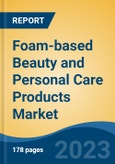Speak directly to the analyst to clarify any post sales queries you may have.
10% Free customizationThis report comes with 10% free customization, enabling you to add data that meets your specific business needs.
Additionally, the market is witnessing innovation in eco-friendly and skin-friendly formulations, aligning with consumer preference for sustainable, chemical-free, and multifunctional products in daily personal care routines. Social media influencers and key opinion leaders (KOLs) significantly impact consumer choices, especially among Gen Z and millennials, who make up 78% of premium organic cosmetics purchasers. Consequently, these consumers increasingly seek high-quality products to improve their appearance and support youthful, healthy skin.
Key Market Drivers
Rising Consumer Demand for Innovative and Convenient Products
Consumers increasingly prefer beauty and personal care products that are easy to use, quick to apply, and effective. Foam-based formulations meet these expectations due to their lightweight and airy texture, which spreads easily and absorbs quickly without leaving residues. For example, foaming facial cleansers efficiently remove dirt and oil without over-drying the skin, while hair mousses offer volume and styling benefits without weighing hair down. The convenience of foam products also appeals to time-conscious consumers seeking efficient grooming routines. Additionally, manufacturers are investing in product innovation, creating foams with unique textures, fragrances, and functional benefits, further driving market adoption.Key Market Challenges
Formulation Stability and Shelf-Life Issues
One of the main challenges in the foam-based personal care market is maintaining formulation stability over time. Foam products, by their very nature, are aerated emulsions that are prone to separation, collapse, or loss of texture if not formulated correctly. Factors such as temperature fluctuations, exposure to light, and improper storage conditions can lead to reduced efficacy, altered consistency, or changes in fragrance.For manufacturers, ensuring the longevity of the foam while preserving its sensory appeal and functional properties can be technically complex and costly. Additionally, the inclusion of natural or organic ingredients, which are increasingly demanded by consumers, can further complicate stability, as these ingredients may degrade faster than synthetic alternatives. Poor product stability can result in negative consumer experiences, returns, and damage to brand reputation, posing a significant challenge for the market.
Key Market Trends
Rise of Clean and Sustainable Beauty
Consumers are increasingly emphasizing sustainability and natural ingredients in their beauty and personal care routines, a trend that has significantly influenced foam-based products. Brands are responding by creating formulations that are eco-friendly, biodegradable, and free from harmful chemicals such as sulfates, parabens, and synthetic fragrances.Innovative packaging solutions, including refillable bottles, recyclable materials, and minimalistic designs, are also gaining traction as companies address environmental concerns. Sustainable foam products appeal to environmentally conscious consumers and align with the growing “clean beauty” movement, which prioritizes health, safety, and responsible sourcing. According to the 2024 Voice of the Consumer Survey, despite inflation and rising living costs, consumers are willing to pay an average of 9.7% more for sustainably produced or sourced products, further driving market growth.
Key Market Players
- Unilever plc
- L'Oréal S.A.
- Kao Corporation
- Johnson & Johnson Services, Inc.
- Beiersdorf AG
- Revlon Inc.
- The Clorox Company
- Coty Inc.
- Edgewell Personal Care Company
- Procter & Gamble Company
Report Scope:
In this report, the Global Foam-based Beauty and Personal Care Products Market has been segmented into the following categories, in addition to the industry trends which have also been detailed below:Foam-based Beauty and Personal Care Products Market, By Type:
- Skincare
- Hair Care
- Others
Foam-based Beauty and Personal Care Products Market, By Distribution Channel:
- Offline
- Online
Foam-based Beauty and Personal Care Products Market, By Region:
- North America
- United States
- Canada
- Mexico
- Europe
- France
- United Kingdom
- Italy
- Germany
- Spain
- Asia-Pacific
- China
- Japan
- India
- South Korea
- Indonesia
- South America
- Argentina
- Colombia
- Brazil
- Middle East & Africa
- South Africa
- Saudi Arabia
- UAE
- Turkey
Competitive Landscape
Company Profiles: Detailed analysis of the major companies present in the Global Foam-based Beauty and Personal Care Products Market.Available Customizations:
With the given market data, the publisher offers customizations according to a company's specific needs. The following customization options are available for the report.Company Information
- Detailed analysis and profiling of additional market players (up to five).
This product will be delivered within 1-3 business days.
Table of Contents
Companies Mentioned
- Unilever plc
- L'Oréal S.A.
- Kao Corporation
- Johnson & Johnson Services, Inc.
- Beiersdorf AG
- Revlon Inc.
- The Clorox Company
- Coty Inc.
- Edgewell Personal Care Company
- Procter & Gamble Company
Table Information
| Report Attribute | Details |
|---|---|
| No. of Pages | 181 |
| Published | September 2025 |
| Forecast Period | 2024 - 2030 |
| Estimated Market Value ( USD | $ 4.91 Billion |
| Forecasted Market Value ( USD | $ 7.69 Billion |
| Compound Annual Growth Rate | 7.8% |
| Regions Covered | Global |
| No. of Companies Mentioned | 10 |









